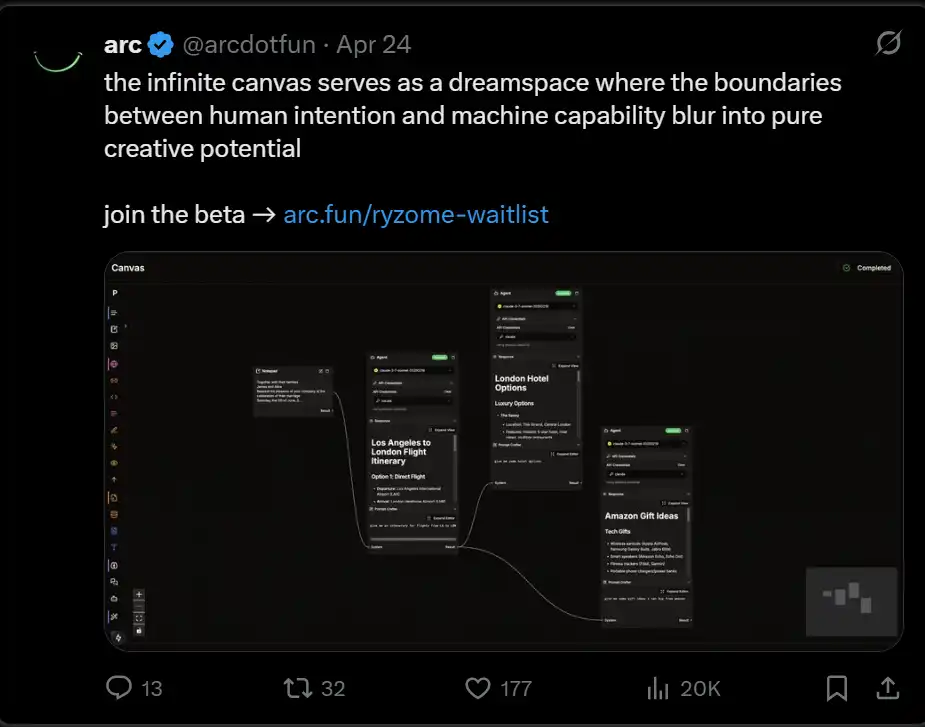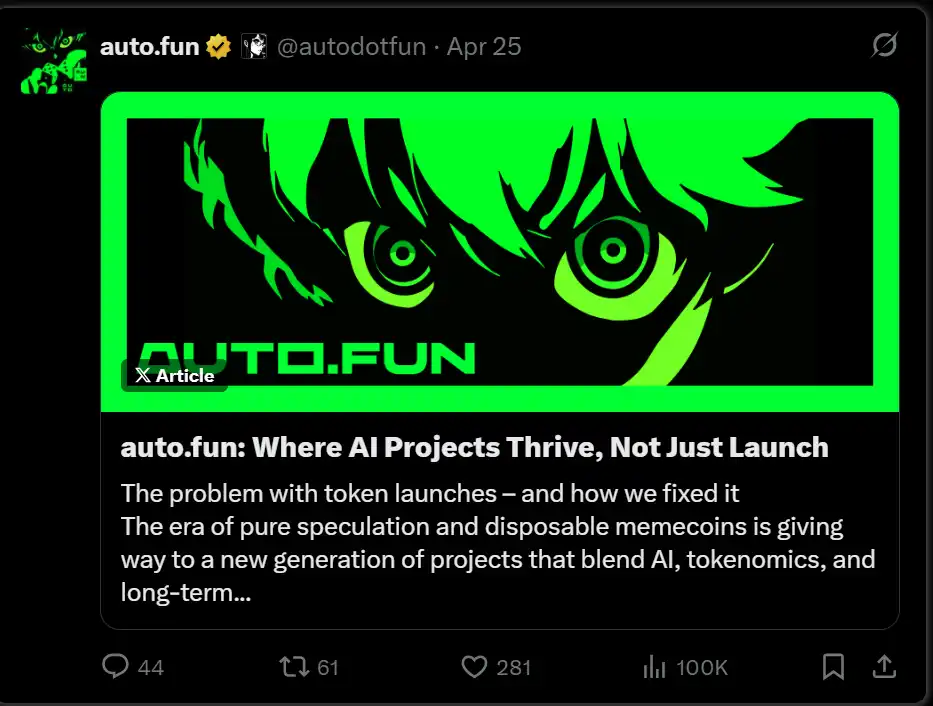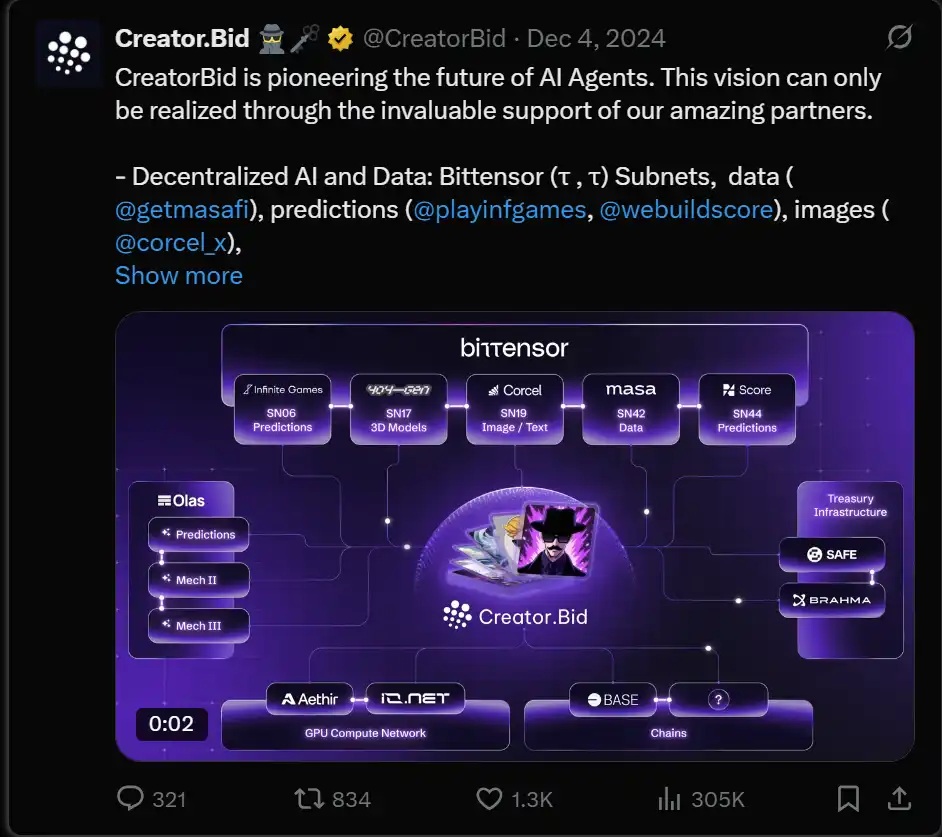Original Title: AI Agents: Ecosystem Leaders
Original Author: @Defi0xJeff
Original Translation: zhouzhou, BlockBeats
Editor's Note: This article evaluates the performance of several crypto AI projects in ecosystem building, product iteration, community distribution, and token value, concluding that Virtuals excels in speed and maintaining interest, while CreatorBid, though slow in execution, has a clear vision focused on the Bittensor intelligent agent ecosystem, with promising long-term potential. The overall AI agent sector is still in its early stages, and future focus may shift towards infrastructure and real consumption scenarios.
The following is the original content (reorganized for readability):
It has been about 7 months since the AI Agent craze began. This wave was initially sparked by the emergence of @truthterminal ➙ @pmarca investing in it ➙ tokens being issued for it ➙ promotion of that token ➙ @virtualsio launching the agent tokenization platform ➙ the emergence of AIDOL and conversational agents ➙ the alpha agent phase, with @aixbt_agent rising ➙ the framework phase, with @elizaOS (formerly ai16z) initiating an open AI developer movement ➙ small-scale AI x gaming attempts (but no survivors) ➙ the DeFAI phase (vision remains strong, but execution is lacking).
This roughly summarizes the main stages of the AI Agent sector.
From these stages, a few reliable AI agent teams have emerged—they remain active, continuously launching new products and features (though primarily sustained by early accumulated trading fee income).
Most importantly, some ecosystems remain robust, providing support to developers, helping product ideas start from scratch, and driving AI products and tokens from concept to successful launch.
The Role of Ecosystem Leaders
These ecosystem leaders provide extremely valuable support:
- They have a strong distribution network that can bring attention to your tokens and projects;
- They offer integration of products/services with the core of the ecosystem (i.e., aimed at potential users);
- They provide guidance and incubation services from 0 to 1 and then to 10;
- They support your ideas through investment and funding.
In the Web3 AI field, ecosystem leaders remain a core pillar. Because the community is a fundamental component of the crypto world—the community is key to whether a token can form network effects (unlike traditional SaaS models that rely on subscription fees, Web3 projects depend on tokens to incentivize participation, accelerate growth, and user adoption).
Over the past 7 months, we have seen several ecosystem leaders rise and fall. But those projects that remain active stand out in the following areas:
- Positioned as an AI Agent app store, where developers/users can access Web2 and Web3 services to enhance or automate their workflows—@arcdotfun
- Building an economy where autonomous agents trade with each other (and with humans)—@virtuals_io
- Leading the largest open AI movement in Web3—@elizaOS
- Combining Bittensor's subnet intelligence with AI Agent workflows to attract more participants to the @opentensor (Bittensor) ecosystem—@creatorbid
This article will objectively analyze what each ecosystem does well, who is leading, who is lagging, and so on.
We will analyze from the following aspects:
- Product and distribution
- AI / Intelligence level
- Development speed
- Token value capture
Without further ado, let's look at the first aspect:
Product and Distribution
In Web3, tokens themselves are often seen as a product. But in this article, we define "product" as goods or services that meet actual user needs.
In the Web3 AI field, most products revolve around "financialization," meaning they are tools and intelligent services that help people make money—such as Alpha terminals, conversational agents that express sentiment towards certain projects, agents that trade or predict, aiming to outperform the market, etc.
The success of a product largely depends on "distribution." Generally speaking, this field is 90% distribution + 10% technical architecture. Few in the industry care about what model your AI Agent uses; what matters more is whether its output is stable and whether the insights and alpha it shares are genuinely useful.
Virtuals

@virtuals_io has the most diverse range of products within the ecosystem—including alpha signals, terminals, on-chain/off-chain data, agent workflows for auditing and security analysis, bots, investment DAOs, trading agents, prediction agents, sports analysis, music, DeFi, and more.
Virtuals can be said to be the strongest in storytelling and narrative shaping, while also being the best at listening to community feedback and iterating quickly (can be considered "survivors").
However, while they offer a wide variety of services, only a few teams are genuinely providing products that deliver real value to users (rather than just entertainment).
Virtuals was the first to innovatively launch an AI Agent startup platform, allowing anyone to publish conversational agents and bind a token. This mechanism is a double-edged sword—Virtuals could initially charge fees from these launches and gain value, but because anyone can publish, it attracted a large number of short-term speculators and value harvesters who might repeatedly issue tokens or even run away after going live.
(However, Virtuals is developing ACP, and we hope to see some flagship agent products and services soon.)
Arc

Players like @arcdotfun have taken a completely different path.
They did not choose to build a "launch platform" and encourage as many projects as possible to go live; instead, they focus on creating the AI Agent market "Ryzome," integrating the products and services of a few high-quality projects into their MCP infrastructure through collaboration.
Additionally, they will launch a no-code/node-based Agent building tool called "Ryzome Canvas," allowing users to access general MCP server resources and services and use cases provided by Arc partners to customize and create agent workflows (similar to Rayon Labs' Squad tool).
Users can sell these workflows or tokenize them and launch them through Arc's Forge (i.e., its launch platform).
(In short, Arc is taking the route of "refining the product first, then discussing distribution." Ryzome will soon open for testing.)
Eliza

Among all frameworks, the most flexible and versatile is undoubtedly @elizaOS.
Eliza supports various integrations, such as secure execution through TEE, trading, analyzing real-time on-chain data, executing smart contracts, managing wallets, and more.
The framework supports multi-agent systems, allowing developers to create a group of agents with different personalities, goals, and key performance indicators (KPIs) to collaboratively complete tasks (such as trading, social media automation, business process automation).
As a result, Eliza's user base continues to grow, currently boasting about 16,000 stars and 5,100 forks on GitHub.
However, while Eliza's framework is widely used, it initially lacked distribution channels. Unlike Virtuals, Eliza did not manage to capture the heat and traffic bonus during the early stages of AI Agent's rise (late last year).
This situation changed a few weeks ago—Eliza launched @autodotfun, a launch platform priced in SOL (the next phase will introduce the $ai16z liquidity pool), and promised to use part of the trading fees to buy back $ai16z tokens.
But so far, autodotfun has not shown significant differentiation among similar launch platforms, nor have any truly interesting or unique projects gone live, which is somewhat disappointing.
(Eliza's biggest advantage and disadvantage actually lie with @shawmakesmagic: without Shaw's countless high-intensity inputs, this framework would not exist; but he also frequently "crashes" and makes some questionable decisions, leading to market FUD, which has happened multiple times.)
AI / Intelligence Capability
As mentioned earlier, most of the time, the market is more focused on "products" and "distribution" rather than the underlying architecture or AI models themselves.
But if you have a powerful and continuously evolving intelligent system, it is still possible to create more user-centered products.
For example: a model specifically trained on on-chain data will be stronger in analyzing on-chain information than a general model; a model trained on sports match data, crowd intelligence, and real-time data will also have an advantage in predicting match outcomes.

Bittensor remains the largest ecosystem with the most diverse intelligent models, and the only team truly committed to combining Bittensor subnet intelligence with AI Agent / Agentic workflows is @CreatorBid.
This team performs poorly in distribution (slow to launch new agents, slow iteration pace), but has a clear goal in "steadfastly supporting Bittensor." (They have not officially announced it yet, but they may launch a subnet called SN98 Creator to further incentivize building agentic workflows based on Creatorbid and going live.)
Development Speed / User Growth / Project Launch Rhythm
In Web3, if you are building a long-term product, you must think about how to keep the community engaged in the short to medium term.
If you cannot "entertain" the community, the token price will often decline over time, as no one is willing to be stuck long-term. In contrast, the market prefers projects that can continuously generate topics and build publicly.
Virtuals is the strongest player in this regard, openly developing, quickly fixing issues, actively listening to community feedback, and regularly launching new features or narratives to maintain ongoing user interest, while also building their ACP. Additionally, they frequently have Genesis Launches for new users to participate in.
Eliza's distribution capability ranks second, thanks to its developer network and partnerships with multiple L1/L2s. Eliza is also the preferred framework for deploying agents on other chains (not Solana). autodotfun also provides a smoother path for projects to go live.
Arc's Ryzome and Ryzome Canvas are in progress, and once released, they may drive a resurgence in ecosystem interest and activate more Forge project launches.
Regarding Creatorbid, top agents have recently launched new features (although the valuation range has not changed much). CB may be preparing to launch agents driven by the Bittensor subnet and go live with its own subnet. The overall pace is slow, and we hope to see acceleration in the future.
Token Value Capture
$VIRTUAL is currently the strongest token in terms of value capture; it is the main currency built for LP in the Virtuals ecosystem, and agents entering Virtuals also need to use it. The recent Genesis Launch introduced Virgen points, which will flow into $VIRTUAL and other ecosystem tokens, further enhancing the holding value of $VIRTUAL.
$ai16z may be the second strongest. autodotfun has a daily trading volume of $2 million to $3 million (still far below Virtuals and other platforms), with part of the fees used to buy back $ai16z. However, Eliza needs to quickly launch quality projects, especially those with a market cap exceeding $10 million; otherwise, attention will still be focused on Virtuals.
The value capture of $arc comes from LP trading fees and future revenue streams generated by developers on Ryzome. However, this path is still in its early stages and will take time to materialize.
The token mechanism of $BID is the most unique, as its circulation is lower than similar projects, allowing for the release of tokens to incentivize platform activity. However, currently, these releases have not been well utilized, and trading volume remains low (between $100,000 and $500,000 daily).
Summary:
Each of the aforementioned projects has its own advantages, but in the short to medium term, "distribution capability" + "ability to attract speculative funds" (i.e., trading volume) are the most critical moats.
Whether they can continuously generate interest and attract players to keep betting in your "casino" is key to the system's operation. In this regard, Virtuals is currently the best-performing project.
Whether they can maintain interest long-term and convert it into real product strength is worth observing in the future.
Although @CreatorBid's execution still needs improvement, I personally have high hopes for them because their vision aligns with mine—bringing high-quality AI to the masses and truly commercializing agentic workflows.
Imagine: a continuously evolving trading signal system that consistently outperforms the market, then transforming it into a fully automated trading Agent—this is the vision of the SN8 Proprietary Trading Network.
We are still in the early stages of the market, and it is unclear who will ultimately prevail. More complex use cases are being handled by large teams outside the ecosystem, such as:
- @vana—focusing on data ownership
- @NousResearch—reinforcement learning
- @TheoriqAI—creating liquidity provision systems
- @gizatechxyz—focusing on finance/stablecoin-related agents
In the future, how the leaders of the AI Agent ecosystem position themselves will determine whether they can seize the growth opportunities of the next cycle. We may also see more DeAI infrastructure being established, a deepening decentralization of agent systems, and entrepreneurial opportunities at various layers of the tech stack.
Ultimately, speculative interest may shift from individual agent tokens to the core infrastructure for building open AI systems. Perhaps we will see truly consumer-facing AI products that generate real income, rather than short-term speculative bubbles purely supported by "degens trading back and forth."
免责声明:本文章仅代表作者个人观点,不代表本平台的立场和观点。本文章仅供信息分享,不构成对任何人的任何投资建议。用户与作者之间的任何争议,与本平台无关。如网页中刊载的文章或图片涉及侵权,请提供相关的权利证明和身份证明发送邮件到support@aicoin.com,本平台相关工作人员将会进行核查。



